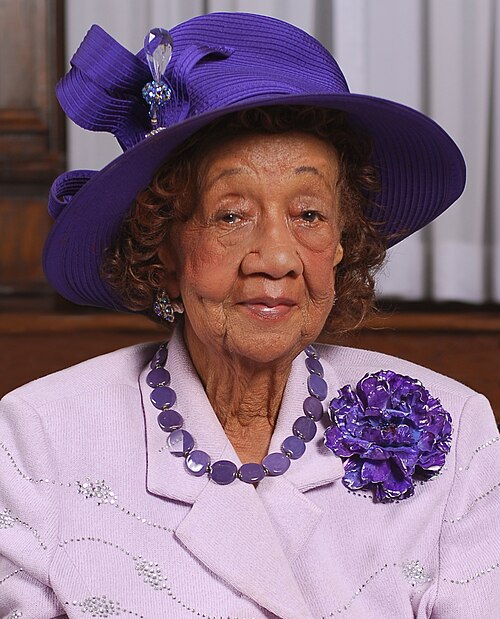If Those Hats Could Talk (1912)
Forrest Gump, sitting on a park-bench, has a one-sided conversation with a disinterested
nurse when he told her, “Momma always says there's an awful lot you could tell about a person
by their shoes. Where they're going. Where they've been. I've worn lots of shoes.”
As much as he obsessed over his footwear, a fellow Southerner was concerned with her hats-and during her nine decades-both literally and figuratively-she wore any number.
The lady who devoted almost a century of her life as a foot-soldier for equality was born in a time and a place where justice was in short supply: women could not vote, and blacks were children of a lesser citizenship. In the belief there would be less racism in the North than in the former capital of the Confederacy, James Height, a builder, and his wife, Fannie, a nurse, migrated to the North. The family, that included Dorothy, Anthanette, Josephine, and Jessie, ended up in Rankin, near Pittsburg. Dorothy was self-conscious about her 5’9” height that she reached at age 11, and her severe asthma led to the diagnosis she would not survive her teens. In addition, she had to confront Jim Crow, the first gentleman of racism. Dorothy’s first lash of racial bigotry occurred when she was eight years old, and her best friend Sally Hay explained she could no longer play with her because she was a “nigger.” Childhood griefs linger, and at age 12, Dorothy was denied entrance to a YWCA pool; when she demanded an explanation the director informed her girls of color were not welcome. A rival basketball team cancelled a competition because Dorothy was not Caucasian. Yet, on one occasion, racism came with a silver lining. In 1928 a new principal arrived at the nearly all-white Rankin High, and his directive forbid Dorothy-who usually led the signing at school assemblies-from doing so again. At the first assembly after his order, when the pianist began the alma mater, the students stayed silent. The accompanist tried twice more with the same result. Finally, the principal motioned Dorothy to the stage and this time the student body rose en masse, and a chorus of youthful voices filled the air. The fact Dorothy could inspire such solidarity among her white peers in pre-Depression America presaged the greatness that was to follow.
During Height’s senior year, she entered an Elks-sponsored national speech contest on the Constitution and was the only non-white in the auditorium with the exception of the janitor. Her topic was the 14th Amendment-intended to extend Constitutional protections to former slaves and their descendants. The jury awarded her first prize: a four-year college scholarship. Barnard College accepted her application but shortly before classes began the dean realized they had already admitted its quota of black students: two. Clutching her Barnard acceptance letter, Dorothy took the subway to New York University. She received a bachelor’s in education and a master’s in psychology. To earn money, Dorothy took odd jobs such as ironing entertainer Eddie Cantor’s shirts and proofreading Marcus Garvey’s newspaper the Negro World. She went night-clubbing in Harlem where she met poet Langston Hughes. Height also became heavily involved in the Civil Rights Movement; whenever there was a lynching in the South, she demonstrated in Times Square, heart and black armband on sleeve. Height often quoted the 19th-century abolitionist Frederick Douglas who said the three effective ways to fight for justice are “agitate, agitate, agitate.”
Upon graduation Height worked as a social worker for the New York City welfare department. However, after attending an international youth conference in Oxford in 1937, Dorothy felt she needed to make more of an impact and left for a position in the Harlem YWCA. One month later she met Mary McLeod Bethune and Eleanor Roosevelt on the same day. Mrs. Bethune, (the daughter of slaves,) was hosting a meeting of the National Council of Negro Women, and the First Lady was to be the guest speaker. The 25-year-old Ms. Height had the role of escort for the esteemed guest, but this singular opportunity almost did not happen when Mrs. Roosevelt entered through the service entrance and was making her way on her own. Dorothy later recounted that she saw her honor going up in smoke. “Who would have thought that Mrs. Roosevelt would park her own car on a Harlem street and come through the service entrance?” Fortunately, Dorothy was able to intercept her. The First Lady gave a rousing speech, and at its close, the ladies serenaded her with “Let Me Call You Sweetheart.” After Eleanor’s departure, Mary made her fingers into a fist to impress upon her followers the importance of women working together to eliminate injustice in the dual spheres of racism and sexism. She told her protégées, “The freedom gates are half-ajar. We must pry them fully open.” Dorothy picked up the baton and Mary’s words became the title of Height’s memoir, published at age 91. The author dedicated it to “my loving mother, Fannie Burroughs Height, and her great expectations.”
The girl who had not been able to dip her toes in the Rankin Y eventually became the director of its office for racial justice. Her first act was to call attention to the exploitation of black domestic day laborers. The women, who congregated on street corners in Brooklyn and the Bronx, known locally as slave markets, were picked up and hired for 15 cents an hour by white suburban housewives who cruised the corners in their cars. On Height’s agenda was the push to end the organization’s practice of separate conferences-one for white leaders and one for blacks. Heads of local chapters in the South refused to meet with her, and she spent nights with local African American families because hotels would not admit black guests. A white police officer threated her life when she defied his order to wait for a train in the “colored waiting room” rather than on the platform with her white colleagues. In response her friends surrounded her, and together they entered the train. When one of the leaders of the NAACP heard of the incident he said, “Dorothy, had you been a black man, you would have been dead.” Through her position, she collaborated with the civil rights movement’s key figures referred to as the Big Six. Height made seven, but they discounted her contributions because she was female.
Throughout her thirty years at the YWCA, Dorothy spent most of her free time volunteering for the National Council of Negro Women-something she did for the next 40 years. She created “Wednesdays in Mississippi,” a 1960s program that brought together Southern and Northern blacks and whites. She organized voter registration drives, set up day care facilities, school breakfast programs, and job fairs. Ms. Height also initiated “pig banks,” that provided livestock for poor families. Another accomplishment was the Black Family Reunion Celebration, a three-day cultural event in Washington, D.C., with related events throughout the country, to help mend African-American’s fractured families where the babies’ Daddies were often AWOL. Height’s mission was to help her sisterhood combat what she called the “triple bind of racism, sexism and poverty.” She stepped down as its president at age 85 but still made daily visits, using a walker or a wheelchair, as she became infirm. The council celebrated her birthday every year with an “Uncommon Height” gala fundraiser. On her 90th birthday, well-wishers such as Oprah Winfrey raised $5 million to pay off the organization’s mortgage on its national headquarters on 633 Pennsylvania Avenue in Washington, the site of what was once a slave market.
Height’s activism led to her sitting at arm’s length from Dr. King as he delivered his “I Have a Dream” speech during the 1963 “March on Washington.” The photographers airbrushed Dorothy, sporting a patterned hat, from the iconic photograph and the historic moment. She had appealed to Bayard Rustin, the events chief organizer, to allow her to speak to give women a voice but the plea proved futile. The only female heard that day was Mahalia Jackson, the gospel vocalist. Ironically, had it not been for Height, there would have been no immortal address. Due to time restraints, each speaker had an allotment of seven minutes; Dorothy made the case that King should be the last at the podium, so his oration could go over time. In 1995 Ms. Height was among the few women to speak at the Million Man March on the Mall, one led by Louis Farrakhan, chief minister of the Nation of Islam. Two years later, at 85, she sat on the podium all day, in the whipping wind and rain, at the Million Woman March in Philadelphia. Less than a month later, at King’s request, Dorothy was in Birmingham, Alabama to minister to the families of the four little black girls who had perished in a church bombing. In 1968, Height rushed to the White House where she and her colleagues tried to advise President Lyndon B. Johnson on how to minimalize black protests and rioting in the wake of Dr. King’s assassination. Ms. Height was the warrior woman amongst men; her quest was to make her people realize that racial prejudice and gender prejudice were on the same side of the contaminated coin. With Gloria Steinem, Shirley Chisholm, and Betty Friedman, Dorothy helped found the National Women’s Political Caucus in 1971.
Dorothy, who had embarked on social activism in her teens, never lost her momentum. Her retirement from her position at the YMCA ended at age 63, but she only did so she could don another hat. She became a visiting professor at the Delhi School of Social work in India. One of oft repeated sayings was, “If the times aren’t ripe, you have to ripen the times,” and forever practiced what she preached.
As was the case with Forrest Gump, Height was present at many of America’s pivotal moments: when President John F. Kennedy signed the Equal Pay Act, Ms. Height was at the White House to witness the ceremony. In recognition of her seven decades of advocacy for racial equality, the Grande dame of the Civil Rights Movement brow-under her ubiquitous hats-received a host of accolades; from President Ronald Reagan the Citizens Medal, President Bill Clinton the Presidential Medal of Freedom, President Bush the Congressional Medal. Other honors were her inclusion in the National Women’s Hall of Fame and a spot on the podium at Barack Obama’s inauguration. On the academic front, Ms. Height received three dozen honorary doctorates from institutions including Tuskegee, Harvard, and Princeton. But there was one academic honor-the equivalent of a bachelor’s degree-that resonated: in 2004, 75 years after turning her away, Barnard College designated Dorothy an honorary graduate.
In a nod to poetic justice the woman who left her stamp on history received a postage stamp bearing her image-in a wide-brimmed purple hat. The unveiling took place at the Rankin Christian Center, the venue of her youthful affront. Dorothy passed away at age 98, till the end fighting to make the 14th Amendment a right nationally acknowledged. Her spirit lives on in a collection of her 250 hats: the white mink she wore she donned to present First Lady Mrs. Roosevelt the Mary Bethune Humanitarian Award, the rhinestone-encrusted one she donned at a gala of the Delta Sigma Theta Sorority, the red, white, and blue she sported at the Democratic Convention that nominated Barack Obama. If those hats could talk what a tale they would tell.


